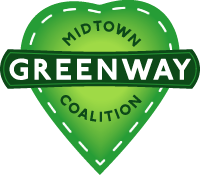Bridges
There are three general categories of Midtown Greenway bridges:
- Historic and new bridges spanning the Greenway’s trench segment;
- The new Martin Olav Sabo Bridge that takes trail users over Hiawatha Avenue;
- A proposed Mississippi River crossing.
Historic and new bridges spanning the Greenway's trench segment
The original bridges were constructed between 1912 and 1916 as the Midtown Greenway gorge was dug to put the active freight rail line down below street grade. This was done to eliminate safety issues related to the trains crossing streets at-grade every block in what were then the new and growing neighborhoods of south Minneapolis. The simple concrete art deco design of these bridges, and their regularity every block, are a defining characteristic of the Midtown Greenway. In fact, the Midtown Greenway corridor has been determined to be historically significant because of these bridges, the configuration of the corridor and its embankments, and the industrial history of the corridor’s use and adjacent buildings. The longest stretch of the Greenway where many of these original bridges remain intact is from 11th Avenue to Cedar Avenue.
Because these bridges are all nearly 100 years old the City of Minneapolis anticipates replacing most or all of them over the next 30 years or so. In recent years the Park and Chicago Avenue bridges were replaced, prior to the corridor receiving historic protection. These new bridges have a somewhat different feel, although their designers attempted to retain some of the feel of the older bridges.
Recently, it was announced that Hennepin County will be completely replacing the bridges at Portland and Cedar. The current design for these bridges mimics the existing bridges nearly 100%, though interestingly, the piers will not be load-bearing. This would allow for easier design for a future streetcar line in the corridor, because the piers could easily be removed without affecting the integrity of the bridge.
Also recently, the bridge at Fremont was closed to car/vehicle traffic, due to safety concerns. The City and County are working on plans to replace the bridge. It is assumed the style would be similar to the proposed bridges at Cedar and Portland.
More information on the historic bridges over the Greenway can be found in a City of Minneapolis Study of their condition and options for their removal or maintenance, including a summary of the study, the study itself, and an action to qualify and accept the study by the Minneapolis City Council’s Transportation and Public Works Committee on
June 5, 2007, as linked below.
Midtown Corridor Historic Bridge Study (8.2 MB pdf)
Midtown Corridor Final Report Summary (254 KB pdf)
Transportation and Public Works Committee action regarding Midtown Corridor Historic Bridge Study (39 KB pdf)
Martin Olav Sabo Bridge over Hiawatha Avenue
This fantastic bridge was paid for by a grant from the United States Congress as a result of advocacy by former Congressman Martin Sabo, with additional funding by Hennepin County. After bridge construction, the County gave the bridge to the City of Minneapolis to own and maintain it.
The slender bridge deck and cable-stayed design were eloquent responses to two design challenges: (1) there were no pier opportunities in the middle of Hiawatha Avenue; (2) the bridge needed to thread through a small vertical opening above the Hiawatha Light Rail Transit Line power supply lines structure, and underneath enormous Xcel Energy power lines.
At night the cobalt blue lights shining on the cables make them appear like lasers in the sky. To learn more, visit the County’s web site.
The bridge was officially renamed the Martin Olav Sabo bridge on May 18, 2008. To watch video of the ceremony, click here.
Mississippi Crossing
The Coalition has long advocated for adding bike/ped trails to Short Line bridge over the Mississippi River. Work was done about a decade ago on this project. Initially, the plan called for putting the trails on the unused southern half of the bridge deck of the existing freight rail bridge that crosses the River at the latitude of 27th Street. That plan was problematic because the Canadian Pacific had concerns about public use of cycling and walking trail so close to an operating freight rail line on the bridge, and because the County felt that the bridge was not sound enough or repairable enough to support the trails long term. The bridge is still being used by the railroad to this day, and they have not indicated when or if they plan to stop using it in the near or even distant future.
Another solution floated was be a brand new bridge parallel to the existing freight rail bridge.
This concept ran into opposition from groups concerned about constructing yet another bridge across the sensitive River gorge, and because the estimated price tag of $12 million would have required additional funders who could not yet be brought to the table. Groups expressing concern included the National Park Service and Friends of the Mississippi. Such a new bridge would likely require the involvement and approvals from three federal agencies, two cities, two counties, three neighborhood organizations, and a host of additional organizations.
A third solution could involve a new freight rail bridge constructed along the alignment of the existing bridge to offer passage for both the freight trains and the trails.
A fourth solution could involve waiting until freight rail no longer operates in this corridor, and then constructing a bike/ped bridge across the River here. The only users of the freight rail here are visiting three destinations along the Hiawatha corridor. If these entities choose to sell their land to developers, the freight trains could go away, but it is unknown if or when that might happen.
The Coalition is open to working with groups that want to see the bridge opened to bike and pedestrians.
